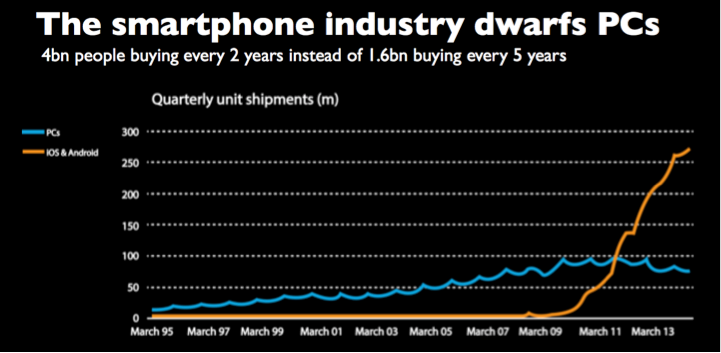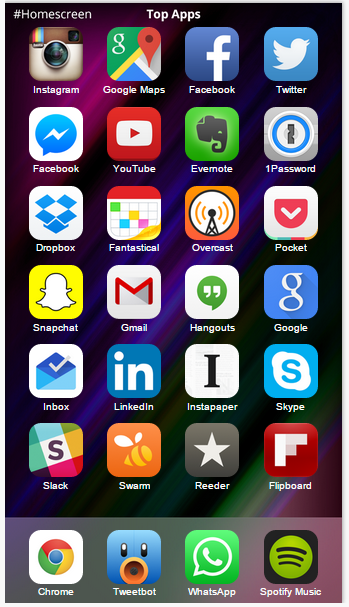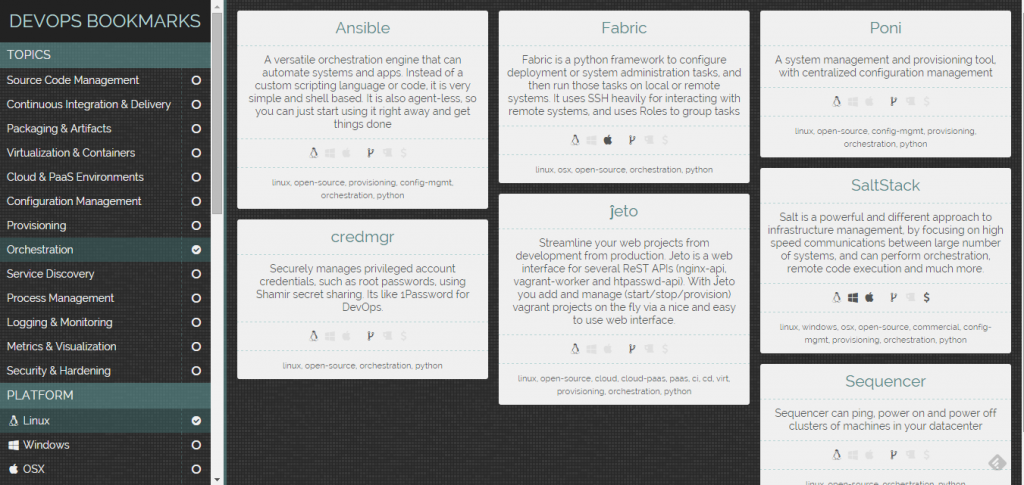Sections
Pick of the Week – Automation and Work
The impact of automation on future human employment prospects is an increasingly important concern for society. The battle lines have been covered in this blog in the recent past. This week, a McKinsey sponsored round table debating the topic raised the spectre of an irreversible structural decline in overall earnings for all except the most highly qualified:
“It’s quite clear, in the US in recent years, that we’re not creating enough good jobs. … 96.2 percent of the US workforce since 2000 is in an educational cohort whose total money earnings, inflation adjusted, have been falling, not rising.
That includes even people with four-year-college degrees and nonprofessional advanced degrees. The only ones that have been rising are the PhDs, on average, and then the professional degrees: the doctors, the lawyers, and the MBAs. So that’s a little sobering if you think about whether we are going to create good jobs.”
Furthermore, many of the new jobs being created are precariat positions that result in a significantly less stable situation for those involved. The only thing being ‘disrupted’ in a lot of cases are individual employment rights:
“the Valley is now awash in so-called “1099 companies,” a reference to the IRS tax form filed by independent contractors. These startups include well known firms like Uber and TaskRabbit as well as a slew of smaller outfits like Handy, Homejoy and Washio. All of them take a category of services normally performed by employees — washing, cleaning, driving and so on — and repackage it as a web-driven platform powered by contractors.”
This NYT Upshot piece also profiles the struggle of the average American worker in the emerging Automation Era. It suggests the real concern is how ordinary workers can retrain and find relevance in the face of ever more sophisticated artificial intelligence and mass-produced robotics. The suggestion that we “just suppose that everything’s going to be O.K. because the magic of the market will assure that’s true” needs to be treated skeptically:
“Lawrence H. Summers, the former Treasury secretary, recently said that he no longer believed that automation would always create new jobs. “This isn’t some hypothetical future possibility,” he said. “This is something that’s emerging before us right now.”
An HBR piece examining the same concerns chronicles the recent rise of industrial robots and how they are displacing human workers in companies from Ford to Foxconn. If anything the article is even more pessimistic given the combination of a global economic imperative to automate, automate, automate and the relentless pace with which it is being done which will is likely in the near future to outstrip human capacity to adapt:
“To be sure, technological progress has always displaced workers. But it also has created new opportunities for human employment, at an even a faster rate. This time, things may be very different – especially as the Internet of Things takes the human factor out of so many transactions and decisions. The “Second Economy” is upon us. It is, quite simply, the virtual economy, and one of its main byproducts is the replacement of workers with intelligent machines powered by sophisticated code.”

Smartphones and Manufacturers
- Samsung’s strategy has traditionally been centrally directed from Korea. It’s a formula that has proved pretty successful to date and satellite offices in Europe and the US have been very much secondary affairs. However, the recent decline in its fortunes has provided a sense of urgency to the need to reinvent itself and it seems that Silicon Valley rather than Seoul will be the crucible of change. CNET previewed the four key business units Samsung has set up in California to respectively overhaul their mobile app portfolio, develop Internet of Things and wearable concepts, cultivate world class product design and establish leading-edge technology partnerships. In all they now have 4000 staff in Silicon Valley, more than Dropbox, Uber, AirBNB and Pinterest combined:
“In Silicon Valley, there isn’t the stigma over failure and there’s more of a willingness to experiment than back in Korea. The goal: Tapping into local talent and chance meetings with start-ups to innovate in areas where the company has struggled, such as software and services. Those aspects will become more vital as Samsung grapples with tougher competition in the mobile market and strives to create products that set it apart from rivals”.
- Samsung remain one of the biggest attractions at CES. The company has been attending for years during which its exhibition presence has become ever more physically dominant covering electronics, HDTV and mobile. This year their focus is going to be on the Internet of Things which they see as the next major driver of growth for the business.

- Samsung are however closing down their ChatOn service which is bundled with their phones because basically nobody is using it. It’s another sign of the genuine competitive pressure that manufacturer-specific messaging software is facing from over the top propositions like WhatsApp, Telegram and YikYak. Simply having an app on a phone at launch isn’t enough to guarantee any sort of success any more in when app stores provide so many compelling alternatives:
“The company blamed “changing market conditions” for the change, but seems that despite a claimed 100 million strong user base, people weren’t really using the software preloaded on so many smartphones.”

- Nokia Chat too is being shuttered. It’s the latest legacy service to be shut down by Microsoft since their acquisition of Nokia’s phone assets. In this case there is an obvious strategic reason to close down:
“it’s not exactly a shock that Microsoft decided to end Nokia Chat in favor of its own Skype.”
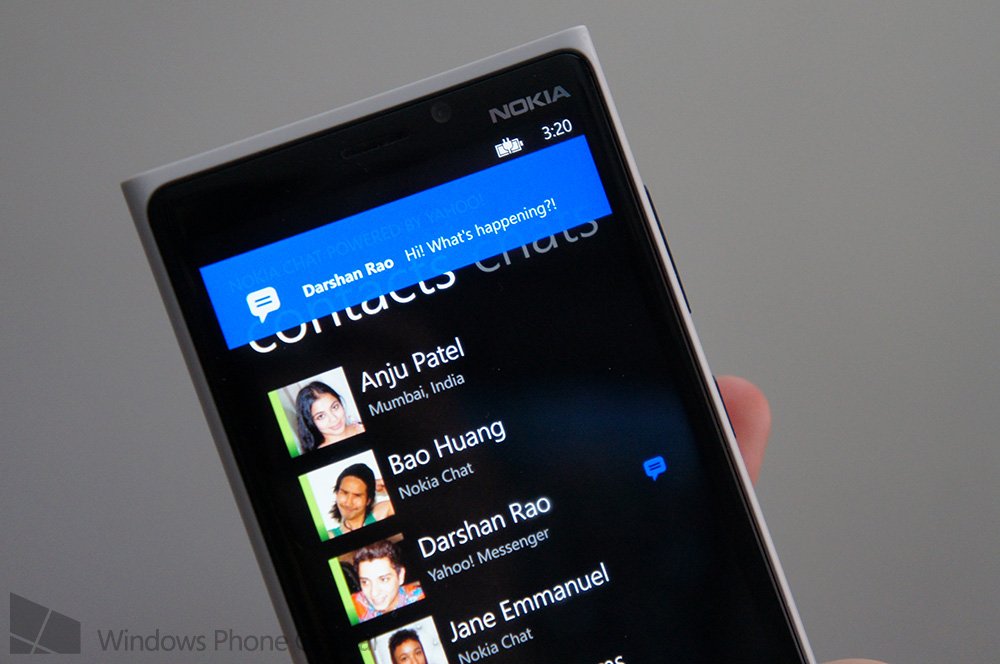
- Qualcomm’s Snapdragon 810 is going to be a big deal in the smartphone world next year. It will power the next generation of leading-edge Android products launched in 2015. GigaOM provided a useful preview of its key features built around a new quad-core 64-bit processor:
“This past year, essentially every high-end Android phone, including the Samsung Galaxy S5, the HTC One M8, the LG G3, the Motorola Moto X (2014), and the Google-designed Nexus 6, all were based around the Qualcomm Snapdragon 801 and 805 chips. And next year, you can expect all those companies to come out with new devices, only running the Qualcomm Snapdragon 810, an improved version, instead.”

- Asymco’s Innovators Stopwatch Part 2 is essential reading to understand the dynamics of the smartphone industry. In it he predicts the ongoing dominance of the Apple Epoch and predicts a coming Indian one rising to real significance in the next three years:
Having observed the market for some time, it’s possible to see a set of “epochs” which show the rise and fall of various platforms/vendors/geographic production areas. I applied these “epochs” as a rough sketch over the production data.
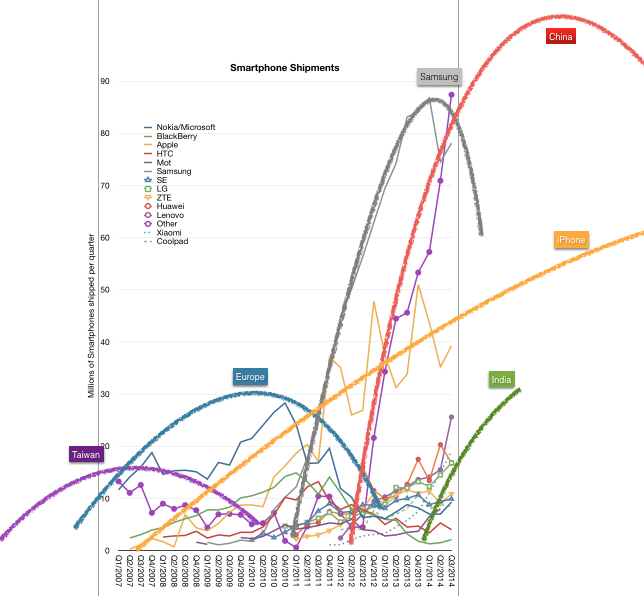
- Peter Diamandis of Singularity University and Space X prize fame is clear that the smartphone explosion constitutes the single biggest megatrend of this decade. In a stimulating Medium post he outlines the implications of extrapolating from this explosion and why it means “tech will infiltrate you, your business, your family, and every aspect of your life.” His comments on the huge disruptive potential of mobile echo similar sentiments expressed by Benedict Evans in “Mobile is Eating the World” and serve to underline just how few people are involved in building today’s multi-billion dollar mobile software giants. If you combine that with the growth trajectory of mobile, it becomes clear that the mobile software industry giants of the future simply aren’t going to employ that many people:
“I often talk about exponential organizations — small teams of people leveraging exponential technologies and resources to scale quickly and disrupt slow-moving incumbent businesses.
Mobile and infinite computing are one of the core drivers allowing this to happen.
Instagram was acquired for a $1 billion with a team of 13 employees.
WhatsApp, an app that was built by a team of 30 people and acquired by Facebook for $19 billion, processes 7.2 trillion messages a year.
In 2000, a business with 100 employees would need to raise $10 million to reach 1 million people.
Today, we see many examples of teams of around 10 people raising $1 million and reaching 10 million people.”
Google and Android
- Another diagram from Diamandis’ article highlights what is becoming a growing strategic problem for Google, namely the explosive growth of “dark social” traffic flowing through mobile apps that cannot be indexed for search or advertising purposes. It’s a development that is causing some analysts to question Google’s future performance projection:
“In a research note sent out Tuesday, JPMorgan’s Doug Anmuth lowered estimates for Google’s revenues, citing concerns with “the transition from desktop to mobile search, continued margin compression, and increasing competition from Facebook.”
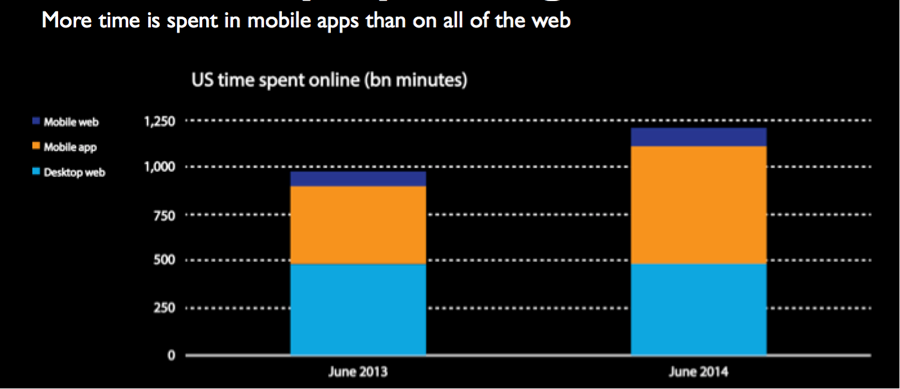
- Still, Google can console themselves with the news that they’re doing better than Russia at least in terms of comparative market capitalization:
“Google GOOG, -0.72% for the first time, is now worth more than the entire Russian stock market. Which one would you buy? “

- Reuters are reporting that Google’s M release which is due October 2015 will be designed for “direct integration” into cars rather than via a docking connector as is the case with the current generation of Android Auto:
“Direct integration into cars ensures that drivers will use Google’s services every time they turn on the ignition, without having to plug in the phone. It could allow Google to make more use of a car’s camera, sensors, fuel gauge, and Internet connections that come with some newer car models.”
- Any such move has clear benefits for Google but it’s less obvious why a car manufacturer would want to limit themselves and, crucially, by extension their customers to a Google-only driving experience:
“Google will have to get support from car-makers who may not want to limit their vehicles to using software that customers might not want.”
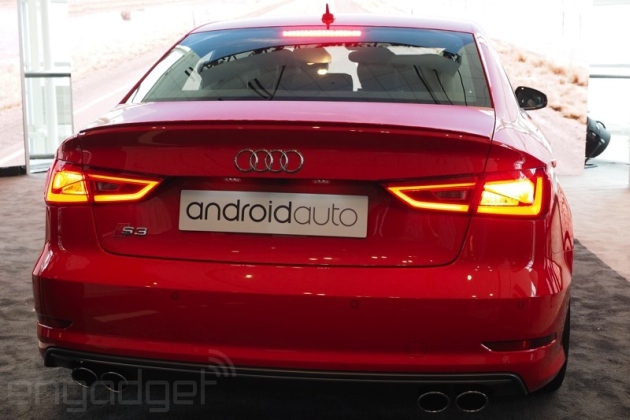
Apps and Services
- Nokia HERE have partnered with Baidu to bring together a global competitive mapping solution independent of either Google or Apple but capable of running on both platforms. It’s an offering likely to do very well with OEMs using the non-Google flavour of Android built on AOSP building products aimed at less developed markets which Nokia seem to be specifically targeting.
Baidu and HERE keep Chinese travellers on the map http://t.co/PXpe8T9Dy1 pic.twitter.com/JlIJYv5DzQ
— HERE Technologies (@here) December 15, 2014
- Ray Ozzie’s voice startup Talko has been covered in this blog before. Medium have published an article more information on their technology stack, specifically their use of WebRTC to support VOIP use cases. It also provides a fascinating insight into how Talko monitor performance and quality issues in field though instrumentation:
“However, when you have a live application in the field, you need a way to ascertain call quality without actually having a user’s device. To help with this, we have implemented methods to upload anonymized VoIP statistics to our server from each endpoint and the media server after each Talko call. This allows us to internally monitor call performance and debug behaviors that groups of users experience while in calls together. Having this visibility is crucial to understanding and diagnosing issues in the field — we are continuously working to improve how we do this.”
- Sonos have partnered with HD streaming music startup Tidal to make their service available to Sonos users. HD music “increasingly is becoming a differentiating feature for anyone trying to carve out a lucrative niche” in the streaming music space:
“Tidal’s catalog offers access to more than 25 million tracks from all major labels, as well as 75,000 music videos, which Tidal subscribers can access on the web as well as through the company’s iOS and Android apps. Tidal is offering its HD streams in the open source FLAC audio format, as well as Apple’s own ALAC format, as 44.1kHz / 16 bit recordings with a bitrate of 1411 kbps. Those extra bits will also cost a bit more: With a monthly fee of $19.99, Tidal is twice as expensive as your regular Spotify subscription.”
- Homescreen.is supply the “ultimate iPhone homescreen” by building a master aggregation of all the apps installed by all their users on their own homescreens. Ordering by count and removing Apple’s own apps yields plenty of the usual suspects in the list including Spotify, YouTube, Evernote, Twitter, GoogleMaps, Facebook, Instagram, Skype, LinkedIn and Gmail. Interesting to see Slack and Overcast in the mix:
“This homescreen is automatically generated based on the most popular apps used by #Homescreen members. We keep separate Dock and non-Dock categories and don’t show the stock Apple apps. Think of it as the ultimate phone!”
- Zawinski’s Law has it that “every program attempts to expand until it can read mail. Those programs which cannot so expand are replaced by ones which can.” The modern corollary in the era of OTT messaging dominance would be that every app expands until it eventually becomes a chat app at least according to the CEO of “messaging as a service” (MaaS) provider, Layer. In this blog post he outlines the rationale behind their proposition:
“Users of an app, by definition, form a community around a shared interest. (After all, they all downloaded the app for a reason.) Communities want to communicate, and communication binds a community together.
We’ve done a huge amount of heavy lifting so the app creator can imagine and have the experience that works for them and brings their users together, without burning valuable time and resources on infrastructure.”
- Encrypted OTT messaging startup Telegram very much fits the disruptive mould highlighted by Diamandis earlier. As with Instagram, Snapchat and WhatsApp before them, they’ve undergone hyperinflationary growth with an incredibly small and lean team. Zero to a billion messages a day in 16 months:
“Thanks to your support, we have reached a new milestone – over 1 billion messages are delivered daily. Telegram now has 50 million active users, adding 1 million new signups each week.
This is insane. 16 months ago Telegram didn’t exist, and today it is used by millions of people all over the world – from Spain and Brazil to Malaysia and South Korea. We spent $0 on advertising Telegram and trusted you – our users – to spread the word. The results are amazing and are entirely your achievement. Thank you!”
- Instagram themselves have 300 million active users according to CEO Kevin Systrom in an interview with AdWeek in which, in between posing in Facebook’s Anti Gravity room with Mark Zuckerberg, he managed to reassert his belief that Instagram is uniquely positioned for a future where image-based communication will become increasingly normalised particularly with teens:
“We are using images to talk to each other, to communicate what we’re doing, what we’re thinking and to tell stories. We continue to learn from and be inspired by the way teens use Instagram. For them, it’s both an artistic platform, and the place where they communicate with friends and keep up with the world around them. We’ve seen teen small business owners, photographers, world travelers, makeup artists, sports stars and cancer patients all use Instagram to share a piece of their identity, connect with peers on shared interests and experiences, and discover other worlds beyond their own.”

- Skype Translator offers another perspective on the massive potential for messaging apps to disrupt communication conventions moving humanity ever closer to an instantiation of the babelfish with what when you look past initial teething issues is real-time Skype text and speech translation. ArsTechnica’s reviewer Peter Bright claimed it was “the most futuristic thing I’ve ever used” in this excited review:
“Truly, this is transformational technology. It’s not often that I use something that leaves me excited, something that makes me say “wow” not out of cynical sarcasm but because I’m genuinely impressed. But Skype Translator did it. Whether you call it a Star Trek Universal Translator or Babel fish, Microsoft is building it, and it’s incredible.”
Asia
- ECommerce in India is on a roll with FlipKart, Amazon and Snapdeal involved in a three-way shootout. However the reality behind the headlines is a little more disturbing as highlighted by this Bloomberg article describing how unscrupulous delivery middlemen are replacing phones with bricks. It’s a literal example of nominative irony since “brick” is a term used in the industry to describe a phone that cannot be turned on.

- The recent awful Uber assault case in India also raised many profound questions about technology and society including whether it is possible to neutrally scale a Western flagship service across the world without taking into account regional and cultural nuances:
“how do we scale services that we take for granted when the social/cultural foundations don’t exist in other nations or there are other social dynamics at play? Do we say “Customers need this service even if we can’t guarantee what we can in the first world”? Or do we take a more nuanced approach (and what does that even mean)? I don’t know.”
- Xiaomi’s rise is profiled in an NYT article which offers this great insight into their regionalised expansion strategy from their President former Google executive Lin Bin who recently proposed a “group planking” exercise that went viral:
“I would put China No. 1, India two, Indonesia three, then hopefully follow with Brazil and Russia,” he said. “The developed countries with tightly controlled carrier networks are not in the top five.”
The countries Mr. Lin identifies all have large populations who still have not bought their first smartphone, meaning Xiaomi has a chance. Still, analysts say the company will have to be skillful in adapting to the local demands of each market.

- Lin’s focus on lean fitness is aptly echoed in Xiaomi’s overall performance which highlights a company with surprisingly “wafer thin” margins:
“The Chinese phone-maker, that’s creeping up on Western manufacturers, made a profit of $56.2m on $4.3bn in revenue last year. That gives the firm operating margins of less than two per cent, far behind companies such as Apple and Samsung, Reuters reported.
Apple’s operating margin in the fiscal year to September 2013 was a sizeable 28.7 per cent, while Samsung’s mobile division had a respectable margin of 18.7 per cent last year.”
- Xiaomi and their fellow Chinese Android OEM are increasingly dominant in China mainly at the expense of foreign brands:
Android OEM share in China, as per Baidu. Foreign share falling towards 1/3 pic.twitter.com/qMQFSAgEFU
— Benedict Evans (@BenedictEvans) December 16, 2014
Security
- Plenty has been written about the attack on Sony systems by North Korean hackers that led to a film release being cancelled. Some commentators have suggested it is the cyber equivalent of Pearl Harbor, a declaration of cyber war on the US. The story certainly runs like the plot of a Hollywood film. However, without underplaying the extent and severity of the damage, particularly to Sony’s reputation, it is important to get a sense of perspective about what happened:
“North Korea (or whoever it was) used code that has been described by Cisco’s security intelligence group as “simplistic, not very complex, and not very obfuscated” to steal social security numbers and intellectual property from a company that stores its passwords in an unencrypted Excel file called Master_Password_Sheet and saves unencrypted, plaintext listings of the unencrypted servers holding its employees’ social security numbers.”
Cloud Computing and DevOps
- Microservices are now very much a thing and so unsurprisingly the subject of an eponymous industry conference, the recent #muCon in London. Several speakers underlined the essential central microservice mantra that there is often significant business value is splitting a large Service architecture along transaction boundaries into a collection of smaller dedicated more easy to maintain microservice components that can be independently delivered:
“The Architectural Monolith’s days are numbered. As companies are becoming more and more agile, and see how they can now adapt in order to innovate and compete faster than their competition, software development teams are being forced to maintain and evolve large, monolithic applications at a pace of change that those architectures were never meant to withstand, let alone embrace!”
- Devopsbookmarks is a really useful swamp guide for navigating the emergent devops toolset. You select a topic, a host OS and a language and get a collection of cards outlining your tool options:
Artificial Intelligence, Machine Learning and Big Data
- This Wired article written by the CEO of health app startup Moov seems to suggest that the way we currently interact with and “humanize” our wearables today is merely a staging post on the path to fully integrate artificial intelligence personae capable of recognising and responding to human emotions:
“Now, tech-derived validation is permeating into everyday aspects of our lives with artificial intelligence. First we saw accelerometer-based fitness trackers like Fitbitand Jawbone UP that would push people to hit 10,000 steps per day. When people didn’t hit that goal, they often felt disappointed in themselves. Taken a step further, my own company Moov, an artificially intelligent fitness coach that trains people the way a personal trainer would, pushes users by giving them real-time feedback while they’re working out. By creating a tough, caring, supportive, and hard to impress coach character, we have humanized the experience and users develop a relationship with the device in the same way they would with a personal trainer. They work harder, in part, because they want to please the Moov coach.”
- Deep Learning is a form of machine learning that involves the construction of software algorithms to build models that are capable of extracting features (or “learning”) from data in the way that humans do. It’s an area undergoing major advances at present led by research initiatives that aren’t widely publicised:
“So much research is happening at places that are not large web companies, and even most of the large web companies’ work goes unreported. Big breakthroughs and ImageNet records get the attention, but there’s progress being made all the time.”
- Jeremy Howard, a leading authority in the world of Deep Learning, outlines the current state of the art in this amazing recent TED talk which also touches upon the global societal impact of a change far more profound than the Industrial Revolution:
- The widely covered story of a double amputee controlling modular prosthetic limbs (MPL) wirelessly through mind control was an astonishing case of the potential for combining machine and human learning:

- In all the excitement, it’s important to realise that even machine learning systems are subject to more prosaic maintenance concerns. According to this recent Google research paper:
“Using the framework of technical debt, we note that it is remarkably easy to incur massive ongoing maintenance costs at the system level when applying machine learning.”
- Apache’s Spark is a big data technology seen as a promising replacement to MapReduce that will allow big data tools to become accessible to generalist developers more familiar with mainstream languages. It’s also just set a new record in data sort performance:
“Spark is an advanced execution engine born out of research done at the AMPLab at UC Berkley. It allows programs to run up to 10x faster than Hadoop MapReduce and when data is on disk, and up to 100x faster when data resides in memory. Spark supports programs written in Java, Scala or Python and uses familiar functional programming constructs to build data processing flows.
Spark has garnered significant attention as a next generation execution platform for Hadoop and is seen by some as a replacement for MapReduce.”
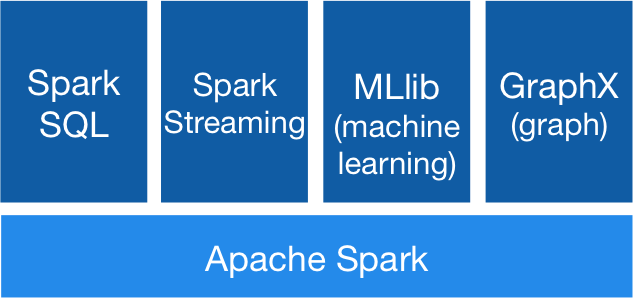
Smart Retail
- McDonald’s in-store beacon trial in the US has apparently been a success meaning that it could be rolled out more widely perhaps taking in the UK. GigaOM provided some more information about the construction of the setup which was built around beacon technology from a company called Piper:
“Using Piper’s beacon implementation over a four-week trial, sales of McChicken sandwiches jumped 8 percent over the prior month while McNuggets saw a 7.5 percent boost.
For the trial McDonald’s chose an app created by Piper that works with both Apple Passbook on iOS and with Google Android devices. How much of an impact did the promotions have? Piper said McDonald’s saw more than 18,000 redemptions for the featured items; Forbes notes the trial took place in 26 locations.”
![]()
- Criteo’s report on the state of mobile commerce suggests it is “unstoppable” and that in 2015 marketers will increasingly focus on the cross-device (or “omnichannel”) consumer journey touchpoints and experience:
Wearables and the Internet of Things
- mHealth is currently experiencing huge growth with Google Play data revealing that:
“Health and Fitness has been the year’s fastest growing app category, reflecting just how much the mobile industry is focused on our well-being — and how much we’re buying into it.”
- The developer opportunity here is tremendous:
“Figures published in a paper on the mHealth app development industry estimate there are now 100,000 apps dedicated to mobile health available for Android and iOS, a figure which has doubled over the last two years. The report shows the global health and fitness mobile app market is worth about $4 billion at the moment, but this could increase to $26 billion by 2017. Google’s data indicates the rise has already begun.”
- Pebble Watch is now able to interact with Android devices in far more sophisticated ways using their new beta Android app which includes “actions that even Android Wear devices themselves don’t perform.“
- Ring by Logbar is “the worst product ever made” according to this hilarious YouTube review which skewers its various flaws:
- This isn’t the Internet of Things, this is a mutant cash register gutted and re-engineered to become a music sequencer called Registroid:
Design
- Designers of the future will need to be literate in multiple disciplines including coding and manufacturing in addition to traditional design competencies:
“Designers are expected to have skills or working knowledge of topics well outside design, including programming and industrial design.”
Work and Culture
- It was inconceivable to anyone present at the height of ancient Egyptian civilisation during the reign of Rameses II nearly 3300 years ago that this mighty empire would eventually collapse with such abrupt totality that it would take 2000 years and the lucky discovery of the Rosetta Stone to decode their hieroglyphic script. It’s a salutary lesson that we in the modern era would be wise to absorb – we should not assume that our civilisation and its cultural output will persist into the far future without a conscious effort on preservation. The Long Now Foundation is preoccupied with precisely such questions. This wonderful Aeon post profiles their solution – a modern day take on the Rosetta Stone:
“The Rosetta Disk takes the principle of the Rosetta Stone to its practical extreme: massive parallelism for maximum intelligibility. A nickel puck just 2.8in across, the Disk is etched all over, microscopically, with more than 13,000 pages in more than 1,500 languages. .. A glass globe shelters the Disk against wear, tear and elemental abuse. .. A copy is ensconced on Rosetta, the European Space Agency’s comet probe, whose plucky lander was named for Philae. As long as the Rosetta Orbiter circles the Sun, it guards the memories of the whole human race.”

- An argument that transparency in a business environment is a distinct advantage particularly within a tech startup:
“What might surprise you (or might not) is that technology is cited as one of today’s most fraudulent industries along with pharmaceuticals. This means that the opportunity is ripe to distinguish your tech startup from closed-up competitors by employing a model of radical openness with investors and clients. … No closed system is safe from the disruption of a more open alternative.”
- If you start with the assumption that nothing is ever your fault, you perpetuate victim status, create conflict and stop learning. According to the CEO of product roadmap software startup Aha, entertaining the premise that maybe a particular situation is your fault is a more powerful place to be:
“If you think or say “It’s not my fault,” you are hurting yourself and those around you.”
- This fascinating examination of transhumanism asks some profound questions about what it would mean for world religion if human consciousness could eventually be unquestionably demonstrated through sufficiently advanced artificial intelligence. Many transhumanists have a non-religious or atheist background and may be inclined to celebrate such an achievement as the ultimate validation of their worldview:
“For at least some within the transhumanist community, the realization of a fully artificial human body would be the ultimate vindication of atheism, and the ultimate debunking of religious mysticism. After all, if human consciousness can be run on a machine, like software, doesn’t that imply that there is no such thing as a “soul”?
- If so, they would be wise to study the history of comparative religion which has survived many such existential crises in the past without so much as a dent:
“If technology shows us something new about how the world works, religions will find creative ways to adapt, just as they always have in the past.”
- Retrofuturism from a thirty year old advert that’s mostly spookily right apart from the all white clothing and environment – this future was certainly bright and not orange:
Interesting CompuServe ad from 31 years ago! pic.twitter.com/KuqNVPXm8Y
— Brilliant Ads (@Brilliant_Ads) December 16, 2014
